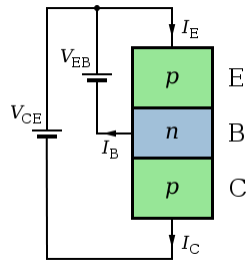Active-mode PNP transistors in circuits

Structure and use of the PNP transistor.
The diagram opposite is a schematic representation of the PNP transistor connected to 2 voltage sources. To make the transistor conduct the appreciable current (on order of 1 mA) from E to C, VEB should be above a minimum value at time referred to as cut-in voltage. The cut-in voltage is nearly 600 mV for silicon BJTs at the room temperature but can be different depending on the type of transistor and biasing of it. This applied voltage creates the upper P-N junction to 'turn-on' allowing the flow of holes from emitter into base. In active mode, the electric field prevailing among the emitter and the collector (caused by VCE) causes the majority of these holes to cross the lower P-N junction into the collector to form the collector current IC. The remainder of holes recombines with the electrons, majority carriers in base, making a current through base connection to form base current, IB. As shown in diagram, the emitter current, IE, is total transistor current, which is the sum of other terminal currents (that is IE = IB + IC).
In the diagram, arrows representing current point in direction of the conventional current - the flow of holes is in same direction of arrows because holes carry positive electric charge. In the active mode, the ratio of collector current to the base current is called the DC current gain. This gain is 100 or more, the robust circuit designs do not depend on exact value. The value of this gain for DC signals is referred to as hFE, and the value of this gain for AC signals is referred as hfe. However, when there is no particular frequency range of interest, the symbol β is used.
It should also be noted that emitter current is related to VEB exponentially. At the room temperature, an increase in VEB by around 60 mV increases emitter current by a factor of 10. Because base current is approximately proportional to collector and emitter currents, they vary in the same manner.
Email based Electronics Devices and circuits assignment help - homework help at Expertsmind
Are you searching Electronics Engineering assignment help expert for help with Active-mode PNP transistors in circuits questions? Active-mode PNP transistors in circuits topic is not easier to learn without any external help? We at www.expertsmind.com offers free lecture notes for Electronics Devices and circuits assignment help and Electronics Devices and circuits homework help. Live tutors are available 24x7 hours for helping students in their Active-mode PNP transistors in circuits related problems. We provide step by step Active-mode PNP transistors in circuits question's answers with 100% plagiarism free content. We prepare quality content and notes for Active-mode PNP transistors in circuits topic under Electronics Devices and circuits theory and study material. These are avail for subscribed users and they can get advantages anytime.
Why Expertsmind for assignment help
- Higher degree holder and experienced experts network
- Punctuality and responsibility of work
- Quality solution with 100% plagiarism free answers
- Time on Delivery
- Privacy of information and details
- Excellence in solving electronics engineering questions in excels and word format.
- Best tutoring assistance 24x7 hours